
An oil platform is a large structure with facilities to extract and process petroleum and natural gas that lie in rock formations beneath the seabed. Many oil platforms will also have facilities to accommodate the workers, although it is also common to have a separate accommodation platform bridge linked to the production platform. Most commonly, oil platforms engage in activities on the continental shelf, though they can also be used in lakes, inshore waters, and inland seas. Depending on the circumstances, the platform may be fixed to the ocean floor, consist of an artificial island, or float. In some arrangements the main facility may have storage facilities for the processed oil. Remote subsea wells may also be connected to a platform by flow lines and by umbilical connections. These sub-sea facilities may include one or more subsea wells or manifold centres for multiple wells.
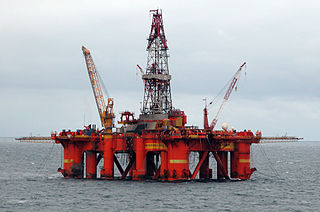
A semi-submersible platform is a specialised marine vessel used in offshore roles including as offshore drilling rigs, safety vessels, oil production platforms, and heavy lift cranes. They have good ship stability and seakeeping, better than drillships.

A floating production storage and offloading (FPSO) unit is a floating vessel used by the offshore oil and gas industry for the production and processing of hydrocarbons, and for the storage of oil. An FPSO vessel is designed to receive hydrocarbons produced by itself or from nearby platforms or subsea template, process them, and store oil until it can be offloaded onto a tanker or, less frequently, transported through a pipeline. FPSOs are preferred in frontier offshore regions as they are easy to install, and do not require a local pipeline infrastructure to export oil. FPSOs can be a conversion of an oil tanker or can be a vessel built specially for the application. A vessel used only to store oil is referred to as a floating storage and offloading (FSO) vessel.

The Brent field was an oil and gas field located in the East Shetland Basin of the North Sea, 186 kilometres (116 mi) north-east of Lerwick in the Shetland Islands, Scotland, at the water depth of 140 metres (460 ft). The field operated by Shell UK Limited was discovered in 1971 and was once one of the most productive parts of the UK's offshore assets but has reached the stage where production is no longer economically viable. Decommissioning of the Brent field is complete with the exception of Brent C, which is producing from another field. The discovery well 211/26-1 was drilled in 1971 by the semi-submersible drilling rig "Staflo". This was a major surprise at the time as the nearest land in Scotland and Norway is composed of granite and other non reservoir metamorphic rocks.
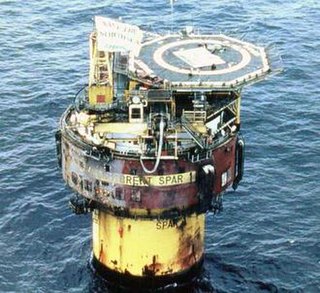
Brent Spar, or Brent E, was a North Sea oil storage and tanker loading buoy in the Brent oilfield, operated by Shell UK. With the completion of a pipeline connection to the oil terminal at Sullom Voe in Shetland, the storage facility had continued in use, but by 1991, was considered to be of no further value. Brent Spar became an issue of public concern in 1995, when the British government announced its support for Shell's application for its disposal in deep Atlantic waters at North Feni Ridge.

A ballast tank is a compartment within a boat, ship or other floating structure that holds water, which is used as ballast to provide hydrostatic stability for a vessel, to reduce or control buoyancy, as in a submarine, to correct trim or list, to provide a more even load distribution along the hull to reduce structural hogging or sagging stresses, or to increase draft, as in a semi-submersible vessel or platform, or a SWATH, to improve seakeeping. Using water in a tank provides easier weight adjustment than the stone or iron ballast used in older vessels, and makes it easy for the crew to reduce a vessel's draft when it enters shallower water, by temporarily pumping out ballast. Airships use ballast tanks mainly to control buoyancy and correct trim.
The Auk Oilfield is situated 249 kilometres (155 mi) east, southeast of Aberdeen, Scotland, in block number 30/16.

The SSCV Thialf is a huge semi-submersible crane vessel operated by Heerema Marine Contractors, and it was the largest crane vessel in the world until the SSCV Sleipnir became the largest in 2019.

DCV Balder is a deepwater construction vessel (DCV) operated by Heerema Marine Contractors.
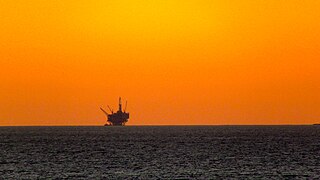
Offshore drilling is a mechanical process where a wellbore is drilled below the seabed. It is typically carried out in order to explore for and subsequently extract petroleum that lies in rock formations beneath the seabed. Most commonly, the term is used to describe drilling activities on the continental shelf, though the term can also be applied to drilling in lakes, inshore waters and inland seas.
Deepwater drilling, or deep well drilling, is the process of creating holes in the Earth's crust using a drilling rig for oil extraction under the deep sea. There are approximately 3400 deepwater wells in the Gulf of Mexico with depths greater than 150 meters.

Devils Tower is a deep-water oil and gas production Spar oil platform located in the Gulf of Mexico and named after Devils Tower National Monument.

A floating wind turbine is an offshore wind turbine mounted on a floating structure that allows the turbine to generate electricity in water depths where fixed-foundation turbines are not feasible. Floating wind farms have the potential to significantly increase the sea area available for offshore wind farms, especially in countries with limited shallow waters, such as Japan, France and US West coast. Locating wind farms further offshore can also reduce visual pollution, provide better accommodation for fishing and shipping lanes, and reach stronger and more consistent winds.
Offshore concrete structures, or concrete offshore structures, are structures built from reinforced concrete for use in the offshore marine environment. They serve the same purpose as their steel counterparts in oil and gas production and storage. The first concrete oil platform was installed in the North Sea in the Ekofisk oil field in 1973 by Phillips Petroleum, and they have become a significant part of the marine construction industry. Since then at least 47 major concrete offshore structures have been built.
The Hutton oil field, located on the UK continental shelf, was the location for the first ever production Tension Leg Platform (TLP).
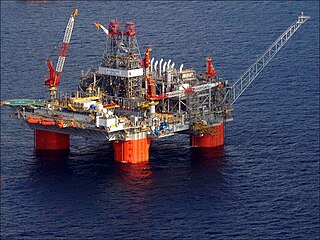
Thunder Horse PDQ is a BP plc and ExxonMobil joint venture semi-submersible oil platform on location over the Mississippi Canyon Thunder Horse oil field, in deepwater Gulf of Mexico, 150 miles (240 km) southeast of New Orleans, moored in waters of 1,840 metres (6,040 ft). The "PDQ" identifies the platform as being a Production and oil Drilling facility with crew Quarters.
A steel catenary riser (SCR) is a common method of connecting a subsea pipeline to a deepwater floating or fixed oil production platform. SCRs are used to transfer fluids like oil, gas, injection water, etc. between the platforms and the pipelines.
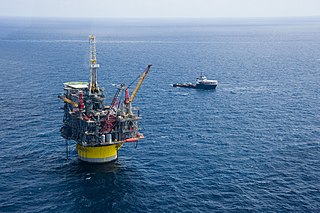
Perdido (Spanish for lost) is the deepest floating oil platform in the world at a water depth of about 2450 meters (8040 feet) operated by the Shell Oil Company in the Gulf of Mexico. The platform is located in the Perdido fold belt which is a rich discovery of crude oil and natural gas. The Perdido spar began production in 2010 and its peak production is 100,000 barrels of oil equivalent (ca. 16,000 m3/d) and 200 million cubic feet of gas per day (ca. 5.7*106 m3/d).

InterMoor is a global mooring, foundations, and subsea services company. Its services include rig moves, mooring and offshore operations such as engineering and design, survey and positioning, fabrication, subsea installation and chain inspections.
The Aasta Hansteen spar is a floating production storage and offloading (FPSO) unit for natural gas operated by Equinor located 186 miles offshore in the Norwegian Sea. It is the first spar platform to be located on the Norwegian Continental Shelf (NCS). The Aasta Hansteen is named after Norwegian painter, writer and early feminist.














